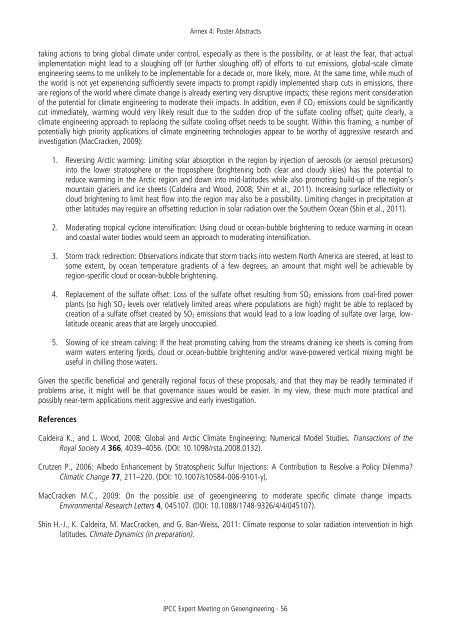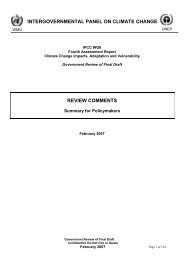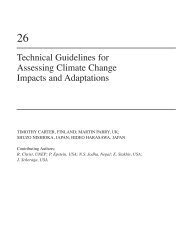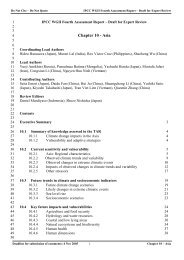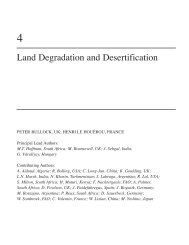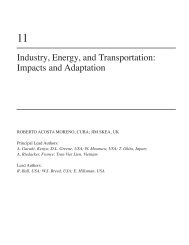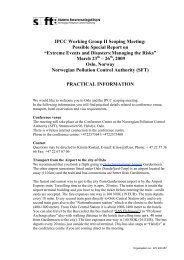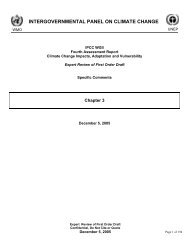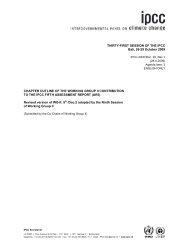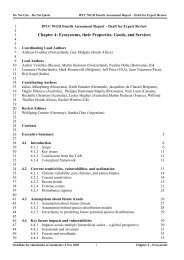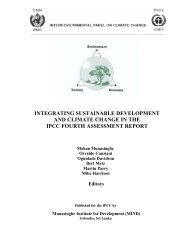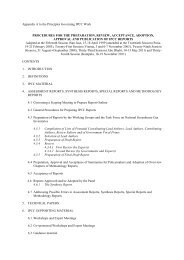IPCC Expert Meeting on Geoengineering
IPCC Expert Meeting on Geoengineering
IPCC Expert Meeting on Geoengineering
Create successful ePaper yourself
Turn your PDF publications into a flip-book with our unique Google optimized e-Paper software.
Annex 4: Poster Abstracts<br />
taking acti<strong>on</strong>s to bring global climate under c<strong>on</strong>trol, especially as there is the possibility, or at least the fear, that actual<br />
implementati<strong>on</strong> might lead to a sloughing off (or further sloughing off) of efforts to cut emissi<strong>on</strong>s, global-scale climate<br />
engineering seems to me unlikely to be implementable for a decade or, more likely, more. At the same time, while much of<br />
the world is not yet experiencing sufficiently severe impacts to prompt rapidly implemented sharp cuts in emissi<strong>on</strong>s, there<br />
are regi<strong>on</strong>s of the world where climate change is already exerting very disruptive impacts; these regi<strong>on</strong>s merit c<strong>on</strong>siderati<strong>on</strong><br />
of the potential for climate engineering to moderate their impacts. In additi<strong>on</strong>, even if CO 2 emissi<strong>on</strong>s could be significantly<br />
cut immediately, warming would very likely result due to the sudden drop of the sulfate cooling offset; quite clearly, a<br />
climate engineering approach to replacing the sulfate cooling offset needs to be sought. Within this framing, a number of<br />
potentially high priority applicati<strong>on</strong>s of climate engineering technologies appear to be worthy of aggressive research and<br />
investigati<strong>on</strong> (MacCracken, 2009):<br />
1. Reversing Arctic warming: Limiting solar absorpti<strong>on</strong> in the regi<strong>on</strong> by injecti<strong>on</strong> of aerosols (or aerosol precursors)<br />
into the lower stratosphere or the troposphere (brightening both clear and cloudy skies) has the potential to<br />
reduce warming in the Arctic regi<strong>on</strong> and down into mid-latitudes while also promoting build-up of the regi<strong>on</strong>’s<br />
mountain glaciers and ice sheets (Caldeira and Wood, 2008; Shin et al., 2011). Increasing surface reflectivity or<br />
cloud brightening to limit heat flow into the regi<strong>on</strong> may also be a possibility. Limiting changes in precipitati<strong>on</strong> at<br />
other latitudes may require an offsetting reducti<strong>on</strong> in solar radiati<strong>on</strong> over the Southern Ocean (Shin et al., 2011).<br />
2. Moderating tropical cycl<strong>on</strong>e intensificati<strong>on</strong>: Using cloud or ocean-bubble brightening to reduce warming in ocean<br />
and coastal water bodies would seem an approach to moderating intensificati<strong>on</strong>.<br />
3. Storm track redirecti<strong>on</strong>: Observati<strong>on</strong>s indicate that storm tracks into western North America are steered, at least to<br />
some extent, by ocean temperature gradients of a few degrees, an amount that might well be achievable by<br />
regi<strong>on</strong>-specific cloud or ocean-bubble brightening.<br />
4. Replacement of the sulfate offset: Loss of the sulfate offset resulting from SO 2 emissi<strong>on</strong>s from coal-fired power<br />
plants (so high SO 2 levels over relatively limited areas where populati<strong>on</strong>s are high) might be able to replaced by<br />
creati<strong>on</strong> of a sulfate offset created by SO 2 emissi<strong>on</strong>s that would lead to a low loading of sulfate over large, lowlatitude<br />
oceanic areas that are largely unoccupied.<br />
5. Slowing of ice stream calving: If the heat promoting calving from the streams draining ice sheets is coming from<br />
warm waters entering fjords, cloud or ocean-bubble brightening and/or wave-powered vertical mixing might be<br />
useful in chilling those waters.<br />
Given the specific beneficial and generally regi<strong>on</strong>al focus of these proposals, and that they may be readily terminated if<br />
problems arise, it might well be that governance issues would be easier. In my view, these much more practical and<br />
possibly near-term applicati<strong>on</strong>s merit aggressive and early investigati<strong>on</strong>.<br />
References<br />
Caldeira K., and L. Wood, 2008: Global and Arctic Climate Engineering: Numerical Model Studies. Transacti<strong>on</strong>s of the<br />
Royal Society A 366, 4039–4056. (DOI: 10.1098/rsta.2008.0132).<br />
Crutzen P., 2006: Albedo Enhancement by Stratospheric Sulfur Injecti<strong>on</strong>s: A C<strong>on</strong>tributi<strong>on</strong> to Resolve a Policy Dilemma?<br />
Climatic Change 77, 211–220. (DOI: 10.1007/s10584-006-9101-y).<br />
MacCracken M.C., 2009: On the possible use of geoengineering to moderate specific climate change impacts.<br />
Envir<strong>on</strong>mental Research Letters 4, 045107. (DOI: 10.1088/1748-9326/4/4/045107).<br />
Shin H.-J., K. Caldeira, M. MacCracken, and G. Ban-Weiss, 2011: Climate resp<strong>on</strong>se to solar radiati<strong>on</strong> interventi<strong>on</strong> in high<br />
latitudes. Climate Dynamics (in preparati<strong>on</strong>).<br />
<str<strong>on</strong>g>IPCC</str<strong>on</strong>g> <str<strong>on</strong>g>Expert</str<strong>on</strong>g> <str<strong>on</strong>g>Meeting</str<strong>on</strong>g> <strong>on</strong> <strong>Geoengineering</strong> - 56


